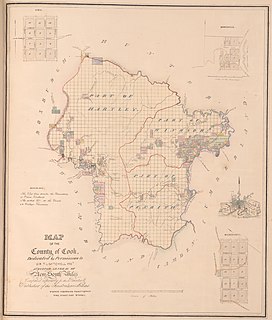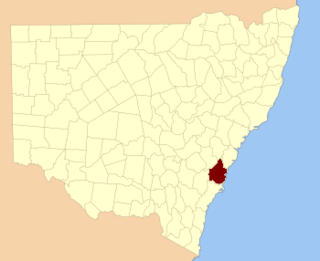Related Research Articles

Cook and Westmoreland was an electoral district of the Legislative Assembly in the Australian state of New South Wales in the first and second Parliaments (1856–1859), named after Cook and Westmoreland counties in the Blue Mountains, Lithgow and Oberon areas. It elected two members simultaneously, with voters casting two votes and the first two candidates being elected. It was largely replaced by Hartley, however both members moved to other electorates, James Martin became the member for East Sydney, while Robert Jamison became the member for Nepean.
Western Division of Camden was an electoral district for the Legislative Assembly in the Australian state of New South Wales from 1856 to 1857. Its name was changed to West Camden between 1858 and 1859, when it was replaced by the electoral district of Camden. It elected two members simultaneously, with voters casting two votes and the first two candidates being elected. The electorate was based on western Camden County, which adjoins the Cumberland County to the south, including the Southern Highlands and, to the east, the Illawarra.
Shoalhaven was an electoral district for the Legislative Assembly in the Australian state of New South Wales from 1859 to 1904. It included the lower part of the Shoalhaven valley. It replaced parts of Eastern Camden and St Vincent. It was replaced by Allowrie.
Eastern Division of Camden was an electoral district for the Legislative Assembly in the then British colony of New South Wales from 1856 to 1857. Its name was changed to East Camden in January 1858, and it was largely replaced by the district of Illawarra in June 1859.
New England and Macleay was an electoral district of the Legislative Assembly in the Australian state of New South Wales from 1856 to 1859, in the Northern Tablelands region of New England and part of the Mid North Coast region, including the area to the north of the Macleay River. but excluding the area south of the Macleay River which was included in the Counties of Gloucester and Macquarie. To the north was the electorate of Clarence and Darling Downs and to the west the electorate of Liverpool Plains and Gwydir. It elected two members, with voters casting two votes and the first two candidates being elected. It was partly replaced by New England.
Eastern Suburbs was an electoral district of the Legislative Assembly in the Australian state of New South Wales. It was created as a five-member electorate with the introduction of proportional representation in 1920, replacing Bondi, Randwick, Waverley and Woollahra and named after and situated in Sydney's Eastern Suburbs. It was abolished in 1927 and replaced by Bondi, Coogee, Randwick, Vaucluse, Waverley and Woollahra.
Cumberland was an electoral district of the Legislative Assembly in the Australian state of New South Wales in outer western Sydney named after Cumberland County. It was created as a three-member electorate with the introduction of proportional representation in 1920, replacing Camden and Hawkesbury. It was abolished in 1927 and replaced by Hawkesbury, Nepean, and parts of Bankstown, Lakemba and Hornsby.
Members of the New South Wales Legislative Assembly who served in the first parliament of New South Wales held their seats from 1856 to 1858. </ref> The Speaker was Sir Daniel Cooper.
Oxley, an electoral district of the Legislative Assembly in the Australian state of New South Wales, was established in 1920, returning 3 members until 1927. It was abolished in 1988 before being reestablished in 1991.
Kiama, an electoral district of the Legislative Assembly in the Australian state of New South Wales, had two incarnations, the first from 1859 to 1904, the second from 1981 until the present.
Goulburn, an electoral district of the Legislative Assembly in the Australian state of New South Wales, has had two incarnations, from 1859 until 1991 and from 2007 to the present.
Southern Highlands, an electoral district of the Legislative Assembly in the Australian state of New South Wales, was established in 1988. It was abolished in 2007 and largely replaced by Goulburn.

The Electoral district of County of Camden was an electorate of the New South Wales Legislative Council at a time when some of its members were elected and the balance were appointed by the Governor.
Murray, an electoral district of the Legislative Assembly in the Australian state of New South Wales, has had two incarnations, the first from 1859 to 1999, the second from 2015 to the present.
Newtown, an electoral district of the Legislative Assembly in the Australian state of New South Wales, was established in 1859.
The 1856 New South Wales colonial election was to return 54 members of Legislative Assembly composed of 34 electoral districts with 18 returning 1 member, 13 returning 2 members, two returning 3 members and one returning 4 members, all with a first past the post system. In multi-member districts, because each voter could cast more than one vote, it is not possible to total the votes to show the number of voters and voter turnout in these districts is estimated. 8 members from 6 districts were returned unopposed.
The 1858 New South Wales colonial election was to return 54 members of Legislative Assembly composed of 34 electoral districts with 18 returning 1 member, 13 returning 2 members, two returning 3 members and one returning 4 members, all with a first past the post system. In multi-member districts, because each voter could cast more than one vote, it is not possible to total the votes to show the number of voters and voter turnout in these districts is estimated. 17 members from 14 districts were returned unopposed. The electoral districts and boundaries were established under the Electoral Act 1851 (NSW) for the former Legislative Council.
A by-election was held for the New South Wales Legislative Assembly electorate of Western Division of Camden on 16 June 1856 because James Macarthur was concerned about the constitutionality of the transition to responsible government and resigned.
Eastern Division of Camden, an electoral district of the Legislative Assembly in the Australian state of New South Wales was created in 1856 and abolished in 1859.
The 1904 New South Wales state election involved 90 electoral districts returning one member each. The election was conducted on the basis of a simple majority or first-past-the-post voting system. There were two significant changes from the 1901 election, the first was that women were given the right to vote, which saw an increase in the number of enrolled voters from 345,500 in 1901, to 689,490 in 1904. The second was that as a result of the 1903 New South Wales referendum, the number of members of the Legislative Assembly was reduced from 125 to 90. The combined effect of the changes meant that the average number of enrolled voters per electorate went from 2,764, to 7,661, an increase of 277%. Leichhardt was the only district that was not substantially changed, while The Macquarie and The Murray districts retained nothing but the name.
References
- ↑ Green, Antony. "Elections for the District of West Camden". New South Wales Election Results 1856-2007. Parliament of New South Wales . Retrieved 24 January 2021.
- ↑ Part 5B alphabetical list of all electorates and Members since 1856 (PDF). NSW Parliamentary Record. Parliament of New South Wales . Retrieved 24 January 2021.
- ↑ "Mr James Macarthur (1798-1867)". Former Members of the Parliament of New South Wales . Retrieved 17 April 2019.
- ↑ "Mr John Norton Oxley (1824-1891)". Former Members of the Parliament of New South Wales . Retrieved 17 April 2019.
- ↑ "Mr William Vandermuelen Wild (1834-1861)". Former Members of the Parliament of New South Wales . Retrieved 17 April 2019.
- ↑ Green, Antony. "1858 Camden West". New South Wales Election Results 1856-2007. Parliament of New South Wales . Retrieved 12 June 2019.
- ↑ Green, Antony. "West Camden by-election 1856". New South Wales Election Results 1856-2007. Parliament of New South Wales . Retrieved 12 June 2019.
- ↑ "West Camden election. Return of Mr James Macarthur". The Sydney Morning Herald . 18 June 1856. p. 4. Retrieved 18 April 2019– via Trove.
- ↑ Green, Antony. "1856 Western Division of Camden". New South Wales Election Results 1856-2007. Parliament of New South Wales . Retrieved 21 March 2015.